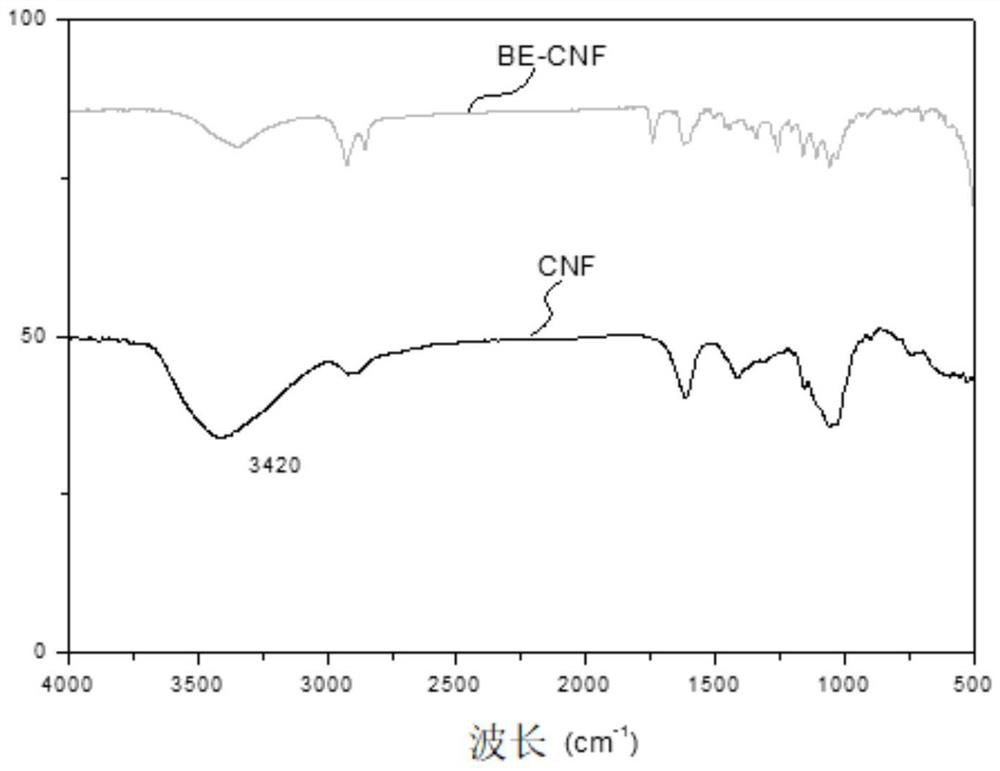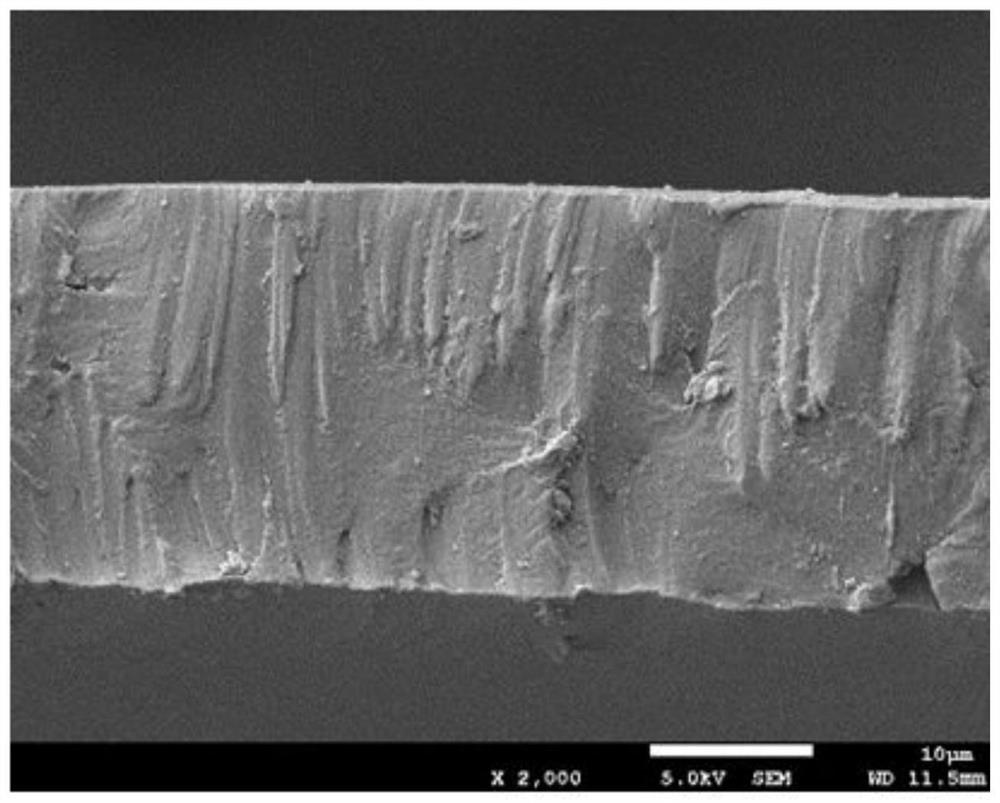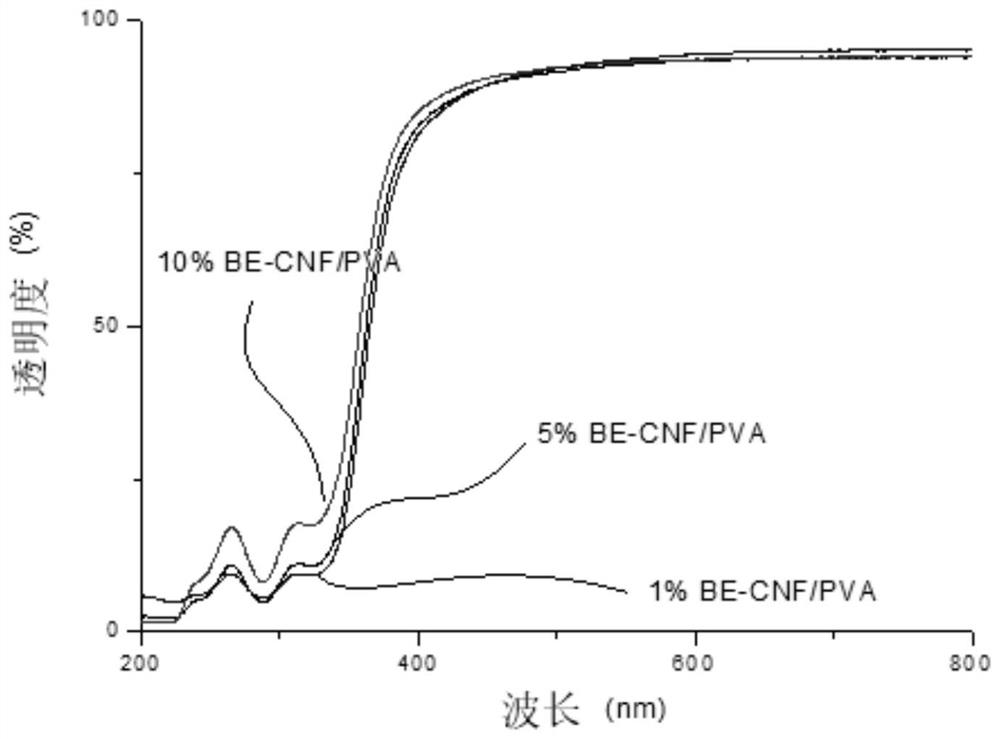A highly transparent anti-ultraviolet nano-cellulose composite film and its preparation method
A nanocellulose and nanofiber technology, applied in the field of highly transparent UV-resistant nanocellulose composite film and its preparation, can solve the problems of harsh reaction conditions and cumbersome steps, and achieve simple modification methods, high-efficiency UV absorption, and extended use The effect of longevity
- Summary
- Abstract
- Description
- Claims
- Application Information
AI Technical Summary
Problems solved by technology
Method used
Image
Examples
Embodiment 1
[0039] A highly transparent anti-ultraviolet nano-cellulose composite film is prepared by the following steps:
[0040] 1) The cellulose nanofiber aqueous solution with a mass percentage concentration of 0.1% is centrifuged and washed with ethanol and acetone several times to remove water, and redispersed in dimethyl sulfoxide with a mass percentage concentration of 0.1%;
[0041] 2) Add 2-hydroxy-4-methoxybenzophenone and epoxidized soybean oil to the product obtained in step 1), continue to pass nitrogen, control the temperature at 120°C, and react for 1 hour; wherein, 2-hydroxy-4 - the mass ratio of methoxybenzophenone and epoxidized soybean oil is 1: 1, and the mass ratio of cellulose nanofibers and 2-hydroxyl-4-methoxybenzophenone is 1: 1;
[0042] 3) After the reaction in step 2), acetone was added to the reacted mixture, stirred at a high speed, and then centrifuged at a speed of 12500 r / min in a desktop centrifuge. Wash away excess 2-hydroxy-4-methoxybenzophenone and ...
Embodiment 2
[0046] A highly transparent anti-ultraviolet nano-cellulose composite film is prepared by the following steps:
[0047] 1) The cellulose nanofiber aqueous solution with a mass percentage concentration of 0.25% is centrifuged and washed with ethanol and acetone several times to remove water, and redispersed in dimethyl sulfoxide with a mass percentage concentration of 0.25%;
[0048] 2) Add 2-hydroxy-4-methoxybenzophenone and epoxidized soybean oil to the product obtained in step 1), continue to pass nitrogen, control the temperature at 120°C, and react for 1 hour; wherein, 2-hydroxy-4 - the mass ratio of methoxybenzophenone and epoxidized soybean oil is 1: 1, and the mass ratio of cellulose nanofibers and 2-hydroxyl-4-methoxybenzophenone is 1: 1;
[0049] 3) After the reaction in step 2), acetone was added to the reacted mixture, stirred at a high speed, and then centrifuged at a speed of 12500 r / min in a desktop centrifuge. Wash away excess 2-hydroxy-4-methoxybenzophenone an...
Embodiment 3
[0053] A highly transparent anti-ultraviolet nano-cellulose composite film is prepared by the following steps:
[0054] 1) The cellulose nanofiber aqueous solution with a mass percentage concentration of 0.5% is centrifuged with ethanol and acetone to remove water, and redispersed in dimethyl sulfoxide with a mass percentage concentration of 0.5%;
[0055] 2) Add 2-hydroxy-4-methoxybenzophenone and epoxidized soybean oil to the product obtained in step 1), continue to pass nitrogen, control the temperature at 120°C, and react for 1 hour; wherein, 2-hydroxy-4 - the mass ratio of methoxybenzophenone and epoxidized soybean oil is 1: 1, and the mass ratio of cellulose nanofibers and 2-hydroxyl-4-methoxybenzophenone is 1: 1;
[0056] 3) After the reaction in step 2), acetone was added to the reacted mixture, stirred at a high speed, and then centrifuged at a speed of 12500 r / min in a desktop centrifuge. Wash away excess 2-hydroxy-4-methoxybenzophenone and epoxidized soybean oil wi...
PUM
 Login to View More
Login to View More Abstract
Description
Claims
Application Information
 Login to View More
Login to View More - R&D
- Intellectual Property
- Life Sciences
- Materials
- Tech Scout
- Unparalleled Data Quality
- Higher Quality Content
- 60% Fewer Hallucinations
Browse by: Latest US Patents, China's latest patents, Technical Efficacy Thesaurus, Application Domain, Technology Topic, Popular Technical Reports.
© 2025 PatSnap. All rights reserved.Legal|Privacy policy|Modern Slavery Act Transparency Statement|Sitemap|About US| Contact US: help@patsnap.com



